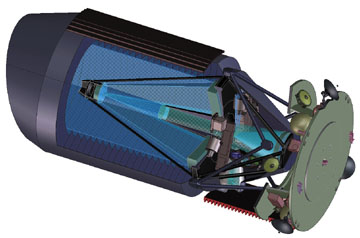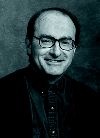
 |
|
| In search of distant supernovae, the proposed SNAP satellite would fly a billion-pixel "Gigacam" made with Berkeley Lab’s new astronomical CCDs. | |
On the front side of an ordinary commercial CCD like those found in video cameras, there is a layer of circuitry, and under that a thin layer where photons are converted to pairs of charge carriers, negative electrons and positive "holes;" the electrons (or holes) are collected in "potential wells" which are read and emptied periodically. Both these layers rest on a sturdy substrate.
Because too much short-wavelength blue light is absorbed in the circuitry, astronomical CCDs must be illuminated from the back. But in the thick substrate, few electrons or holes can reach potential wells before recombining, so the substrate must be tediously removed, destroying many chips.
"Steve wanted to make a CCD that could go straight off the wafer and into the telescope," says Donald Groom of the Physics Division, who is helping to develop the astronomical CCD. "The first step was to make a back-illuminated chip that was sensitive to blue light without thinning."
The method depends on using very pure, negatively doped (n-type) silicon in which electrically active dopants amount to only about one part in a hundred billion; special care is needed to maintain the level of purity.
"In our high-energy work we had developed a unique combination of techniques for ‘gettering’—getting rid of impurities—to produce detectors with low dark current," Holland explains. Dark current is caused by charges not created by incoming photons, but by thermal energy in the material itself.
The pure material offers a unique advantage: "By layering a thin, transparent window onto the back of the n-type silicon substrate—a window that also acts as an electrode—we can apply a bias voltage between the window and the positively doped channel layer under the front circuitry," says Holland. The voltage "fully depletes" the substrate’s charge density—that is, it clears the silicon of charge carriers. Such material is called high-resistivity silicon.
The result is that when a photon of blue light produces a hole near the back surface of the chip, the hole can travel all the way through to the front layer without being lost to recombination. Spatial resolution is good, because the charge carriers accurately reflect the position of the photons that produced them. In blue light, the 300-micrometer-thick, fully depleted chip electronically mimics a thin chip.
In red light, the thick chip does much better than a thin one. A thick chip has much more material in which the long-wavelength photon can interact. Unlike a thin chip—in which interference fringes produced by multiple reflections create severe problems for astronomers who study very distant, highly redshifted objects—in a thick chip under voltage the charge carriers travel nearly straight to the potential wells, with little sideways diffusion.
In tests at the Detector Development Laboratory at the University of California’s Lick Observatory, a Berkeley Lab CCD with four million pixels showed remarkable response across the spectrum, from long-wavelength infrared light well into the short-wavelength x-ray region; indeed, in the near-infrared the Berkeley Lab CCD showed better quantum efficiency—the ratio of incoming photons converted to electric charge—than any astronomical CCD in use. Already an eight-million-pixel CCD is being fabricated for spectroscopy at the giant Keck Telescope in Hawaii.
After
graduating from the University of Kansas, Stephen Holland
got his doctorate in electrical engineering from UC
Berkeley in 1986. "Most people with my background went
right to Silicon Valley," he says, but the Microsystems
Lab was just starting in Berkeley Lab’s Physics Division
and offered more challenging research opportunities.
"I got in on the ground floor." Holland’s interest in
silicon-based radiation detection has led to ever more
practical and versatile applications.
Because the CCDs are used "backside-up," the circuitry is hidden,
and their light-sensitive surfaces can fit side by side to form very large
arrays. Berkeley Lab scientists propose to put a mosaic camera using 128
nine-million-pixel chips into a satellite dubbed SNAP, for SuperNova/Acceleration
Probe. With a billion pixels, SNAP’s optical imager will be the largest
and most sensitive astronomical imager ever made.
STEVE
HOLLAND
![]()

![]()
"Fabricating an astronomical CCD turns out to be enormously more complex than fabricating high-energy particle detectors," says Holland; the new CCD requires much more expensive masks and many more of them, very accurate registration between layers, and three layers of silicon for the electrodes. Most of the fabrication has been done at Berkeley Lab’s Microsystems Laboratory, managed by Nick Palaio of the Engineering Division, a facility originally developed to support the Superconducting Supercollider.
The work has already begun to pay off. Noted astronomer Joel Primack of the University of California at Santa Cruz has voiced the opinion that "these CCDs will transform astronomy."
Along with his many Berkeley Lab colleagues, Holland credits Richard Stover, Mingzhi Wei, Kirk Gilmore, and Bill Brown of Lick Observatory and James Janesick of Pixel Vision, Inc. for making crucial contributions to the technical development of the new CCD. Special equipment was acquired through a grant from the California Association for Research in Astronomy (CARA) and also donated by the Intel Corporation.
For complete technical details of the new high-resistivity CCD, visit
the web at http://ccd.lbl.gov/.
— Paul Preuss
|
Next > | |||